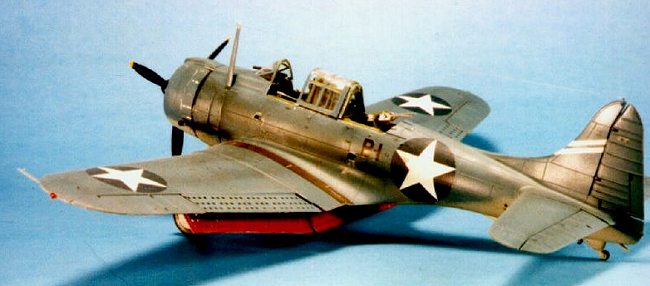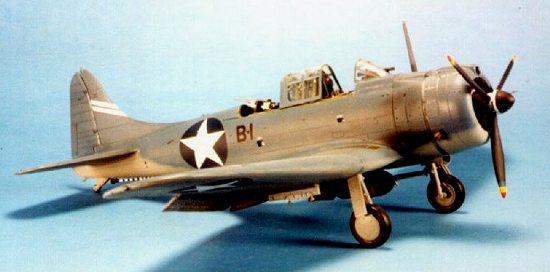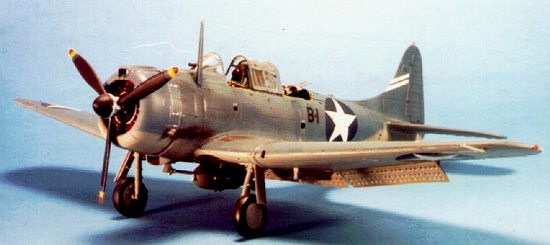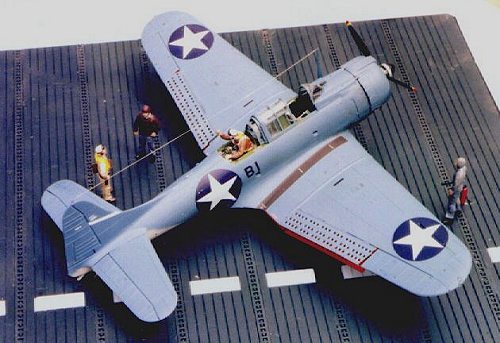
Accurate Miniatures 1/48 SBD-3
|
KIT # |
3411 |
|
PRICE: |
$34.95 |
|
DECALS: |
See Review |
|
REVIEW : |
|
|
NOTES: |
` |

|
HISTORY |
In light of the situation in which we find ourselves after the tragic events of Tuesday, September 11, 2001 - a day that will truly live in infamy - I am going to present a series of articles on building models of aircraft flown by American heroes of the Second World War whose stories I find particularly compelling, and illustrative of Americans at their best. These are not all new models; I will provide all information for you to build them. Modeling is a great way to give oneself a break from the pressures of life around us, and while building one of these models, perhaps you can consider the story that comes with it.
Dick Best and the Battle of Midway:
The truly-decisive naval battles throughout history have been decisive on a far wider range than merely the battlefield, or even the war in which the event took place. At Salamis, the Athenian galleys not only defeated the Persian invasion fleet of Xerxes, but determined that Western civilization would continue to exist and develop as a world force. Trafalgar didn't merely mean that Napoleon would not be able to invade England and would thereby end his career in defeat; it meant Great Britain would be the dominant world power for next 100 years. So, too, the Battle of Midway, fought June 4-6, 1942, did not merely mean the United States would eventually win the Pacific War; it marked the birth of what has come to be called "The American Century."
In every great battle, there comes a moment when it truly seems the Gods of War have chosen the winner, when one side - despite its best efforts - cannot do other than lose, while the other sweeps on to victory. At Midway, this came at 10 a.m. on the morning of June 4, 1942, when the Douglas SBD Dauntless dive from the U.S.S. "Enterprise" arrived over the Japanese fleet force at its single most vulnerable moment.
 At that moment, the United
States was losing the battle. The air forces on Midway had launched strikes that
had been unsuccessful. The Japanese had struck Midway at dawn, and now prepared
the second strike to knock out what was left of Midway's defenses, so the
accompanying invasion fleet could take possession of the strategic mid-Pacific
atoll.
At that moment, the United
States was losing the battle. The air forces on Midway had launched strikes that
had been unsuccessful. The Japanese had struck Midway at dawn, and now prepared
the second strike to knock out what was left of Midway's defenses, so the
accompanying invasion fleet could take possession of the strategic mid-Pacific
atoll.
Just as Admiral Nagumo gave the order to launch the second strike at Midway, a garbled message came in from a scout plane launched earlier that morning by the cruiser "Chikuma" that indicated at least one American carrier was operating to the northeast. This was met with incredulity on the part of the Japanese; all their plans for the Midway battle were based on the presupposition that U.S. carriers would not arrive until after the island had been neutralized. For Nagumo, there should be no carrier where the scout had reported it. If the message was accurate, the Battle of the Coral Sea the previous month had shown that the first strike by either side would be decisive. Nagumo could not take the risk of launching against Midway and allowing the main enemy to make that first strike. He prepared to fight a fleet action.
This meant unloading the high-explosive bombs from the strike aircraft and reloading them with armor-piercing bombs and torpedoes. In the midst of the reload, another strike of Midway aircraft seemed to demonstrate the need to neutralize the known enemy, while a second garbled message from the scout seemed to negate the first. Nagumo ordered a second reload for the Midway strike; halfway through, a third message from the "Chikuma" scout stated clearly there were two American aircraft carriers northeast of Midway. When the third reload was ordered, the exhausted deck crews left bombs lying on the decks next to fully-fueled and armed aircraft as they rearmed in the middle of an attack by American torpedo bombers from "Yorktown," "Enterprise" and "Hornet," in which 32 of 36 attackers were shot down without damaging the fleet.
The torpedo bombers' sacrifice had drawn the Japanese Combat Air Patrol down to wavetop level at just the right moment. With the last of the American torpedo bombers shot down, Nagumo ordered his carriers to turn into the wind and commence launching their strike. As the first Zero accelerated down the deck of Nagumo's flagship, the lookouts screamed their warnings. High above the fleet, sunlight flashed on the canopies of the American dive bombers as they commenced the single most important attack of the Pacific War. There was no time for the Japanese to do anything other than brace themselves.
Even with this tactical advantage, the "Enterprise" bombers almost blew the opportunity due to the fact that Air Group Commander C. Wade McCluskey - previously the fighter commander before fleeting up to Group Commander in May - was flying his first strike mission ever, was unfamiliar with dive bomber doctrine, which called for the lead squadron - VS-6 - to fly across the fleet to the far carrier of the two he had decided to attack, which would allow the second squadron - VB-6 - to make a simultaneous strike on the near carrier. Instead, McCluskey dove on the first carrier he saw.
Leading Bombing-6 was Lieutenant Richard H. "Dick" Best, Jr., Annapolis class of 1932 and a Naval Aviator since 1936. Best had transferred from fighters, where he had been a flight leader with VF-2, the elite "Flying Chiefs" squadron, to bombers in 1940, "because I knew we were going to war soon, and I wanted to make certain I was in a position to take the battle to the enemy." As Best looked down at the Japanese fleet below, he says he remembered the sight that had met his eyes on the evening of December 7, 1941. "I thought about Pearl Harbor. We on 'Enterprise' had been delayed a day due to bad weather while returning from taking a Marine fighter squadron to Wake Island. When I flew in to Ford Island that evening and saw the ships sunk, saw the airplanes destroyed, and learned of my friends who had been killed in that attack, I decided then I would do everything in my power to make them regret they had done that to us." The United States was about to be very lucky that Lieutenant Best had transferred to dive bombers.
The first thing Best knew of the error was when McCluskey's SBD dove directly in front of him. With the exception of Best's three-plane lead section, the other aircraft of VB-6 dove with McCluskey and VS-6. In an instant, Best was left alone over the Japanese fleet with only two other dive bombers. He led the trio to the far carrier, and pushed over in what would be recorded as the single most accurate and devastating dive bomber attack of the entire Second World War.
 "I centered the sights on
that big red rising sun painted on the deck," Best recalled to me this past
April as though it was yesterday while we sat in his comfortable living room
here in Los Angeles. "The flight deck was holystoned yellow and made an
excellent target. I dropped my bomb at minimum altitude and as I pulled out I
looked over my shoulder in time to see it hit just forward of the meatball."
"I centered the sights on
that big red rising sun painted on the deck," Best recalled to me this past
April as though it was yesterday while we sat in his comfortable living room
here in Los Angeles. "The flight deck was holystoned yellow and made an
excellent target. I dropped my bomb at minimum altitude and as I pulled out I
looked over my shoulder in time to see it hit just forward of the meatball."
The other two members of the VB-6 lead section, Lt(jg) Bill Kroeger and Ensign Ens. F. T. Weber dropped their thousand- pounders. Kroeger's hit amidships and Weber's right amidst the fully-fueled and armed strike aircraft waiting to take off. "By the time I leveled off," Best recounted, "the carrier was afire from bow to stern." In that moment, the United States had won the Battle of Midway and taken its first step on the beginning of the end of the Pacific War.
Best paid an excruciating personal price for this. During the flight out from the U.S. fleet, the bombers had been at high altitude, and his oxygen rebreather system failed. On the return flight to "Enterprise," Best began coughing up blood and after landing he went below to his room and coughed up enough blood that he felt faint. The failure of the rebreather had triggered incipient tuberculosis, to which he had been unknowingly exposed as a child. Nevertheless, following the Japanese strike on the U.S. fleet that saw the U.S.S. "Yorktown" hit, Best went out with the surviving dive bombers to sink the last Japanese carrier, the "Hiryu." When he landed back aboard "Enterprise," his naval career was over and he began a ten year battle for his own recovery from tuberculosis, which was ultimately successful. At age 91, he resides in here in Los Angeles.
Best pulls no punches in his judgments on history. "We could have saved the torpedo bombers with a combined strike, but McCluskey blew it, when he flew right over what we had plotted as the likely Japanese course, and then flew on to the limits of range before he made that right turn he should have made 25 minutes earlier." Best believes the young pilots who were lost to fuel starvation (over 50 percent of the strike force) might have had a better chance of returning to the ship had they not had to add nearly 40 minutes of formation flying to what was already a maximum-range strike. "I knew we had blown it, because I had it plotted and I was an excellent navigator, but we were maintaining radio silence and there was no way to catch up with Mac and convince him to turn, without burning too much fuel to make it to the target," Best recounted to me with an air of regret.
In March, 1998, at the 41st Anniversary Celebration of The Air Museum, "Planes of Fame" in Chino, California, Dick Best - an honored guest - was offered the opportunity to take a ride in the Museum's SBD-5 Dauntless but declined, saying, "The last time I was in one, I sank two Japanese carriers. How could I ever top that?"
|
THE KIT |
Many modelers will argue over whether it is the Accurate Miniatures SBD Dauntless or TBF Avenger that makes up into the best, most-accurate, most-detailed plastic kit ever as an OOB project. Myself, I come down on the side of the SBD, but for the reason of liking the Dauntless better - not for any intrinsically-better quality of the model. It's really a choice of six of one, half a dozen of the other kit-wise. As with many, I was sad to learn those kits were gone, at least under the Accurate Miniatures banner - we should, however, see them begin to be re-released next year by Italeri.
|
CONSTRUCTION |
 The original Accurate
Miniatures SBD-3 kit was of the early SBD-3 that had the single gun rear turret.
It is not merely a case of adding a second gun to get an accurate Midway
airplane, however; there are significant detail differences in the cockpit and
the rear fuselage decking. Fortunately, in their last release of the Dauntless,
AM did a special kit that allows a modeler to do an early SBD-3, a Midway SBD-3
or an SBD-4; if you have one of these kits, making this airplane is easy. Mine
was made a few years back, and it only happened because Bill Bosworth sent me
the trees with the SBD-5 cockpit parts and fuselage, which are necessary to
create the later SBD-3.
The original Accurate
Miniatures SBD-3 kit was of the early SBD-3 that had the single gun rear turret.
It is not merely a case of adding a second gun to get an accurate Midway
airplane, however; there are significant detail differences in the cockpit and
the rear fuselage decking. Fortunately, in their last release of the Dauntless,
AM did a special kit that allows a modeler to do an early SBD-3, a Midway SBD-3
or an SBD-4; if you have one of these kits, making this airplane is easy. Mine
was made a few years back, and it only happened because Bill Bosworth sent me
the trees with the SBD-5 cockpit parts and fuselage, which are necessary to
create the later SBD-3.
As regards construction, I found over the five Dauntless kits I built that one merely needed to follow the instructions, use the color photos in the Detail & Scale Dauntless book for painting instructions in the cockpit, and to be careful with the fiddly bits of the instrument panel, rudder pedals and foot guides in order to come up with a beautiful model. Oh, all that and I also discovered that if you assemble the lower wing to the fuselage, then attach the upper wings, you will have no need of using any putty other than some Mr. Surfacer for the centerline seam on the fuselage. If you are going to "stack" the canopy in the open position, it's a good idea to sand down each of the interior parts of the stack, so everything looks just right in the end; test-fitting all this will show you exactly what you have to do.
|
PAINT & DECALS |
I painted the model with Gunze Sanyo H-43 "Blue Grey," a gloss color, and H-51 Light Gull Grey. Dick Best himself told me that the aircraft of VB-6 at Midway were new and very clean; the squadron had operated the SBD-2 until mid-May 1942, and picked up replacement SBD-3s that were only a month from factory-new when the "Enterprise" came back to Pearl Harbor after escorting the Doolittle Raid. I did apply pre-shading to the model, but did not do any paint fading during the painting process.
As to decals, I used national insignia from the Aeromaster SBD sheet (now out of production), and cut "B-1" from a letter-and-decal sheet in the decal dungeon. If you have the last AM release, you can use the kit decals for the national insignia, and cut and trim "B-1" from the kit markings.
 After the model had been
Futured, then covered with two coats of thinned Dullcote, I applied the exhaust
stains with Tamiya "Smoke."
After the model had been
Futured, then covered with two coats of thinned Dullcote, I applied the exhaust
stains with Tamiya "Smoke."
The Diorama:
I have also included here a shot of a diorama I made for a friend back in 1998. It is the moment that Dick Best came on the flight deck of "Enterprise" to board his airplane and take off for the strike. He carries his plotting board, while his gunner is seated in the rear turret checking the guns, and his plane captain, in the brown jersey, gets ready to help him up onto the wing. The figure of Best is done with the Monogram TBD pilot, minus the clipboard and with a modified arm to carry the plotting board that is included in the AM kit. The other figures come from a Verlinden set as does the carrier deck section. The diorama has since been donated to the National Naval Aviation Museum in Pensacola, so you can see it in more detail if you ever visit there.
|
CONCLUSIONS |
It is said that the Pax Britannica was born in Nelson's blood on the quarterdeck of H.M.S. "Victory" at Trafalgar. It might be fair to say that The American Century was born in the blood on the floor of the cockpit in Dick Best's SBD over the Japanese fleet that day 59 years ago. Certainly, Best's Dauntless is one of the most significant airplanes of the war for his performance in sinking the "Akagi" under conditions where it was not supposed to be possible. One could do far worse that be inspired by the example of LCDR Richard H. Best, Jr. (a lifelong registered Democrat, by the way :-)).
Copyright ModelingMadness.com. All rights reserved. No reproduction in any form without express permission from the editor.
If you would like your product reviewed fairly and fairly quickly, please contact the editor or see other details in the Note to Contributors.